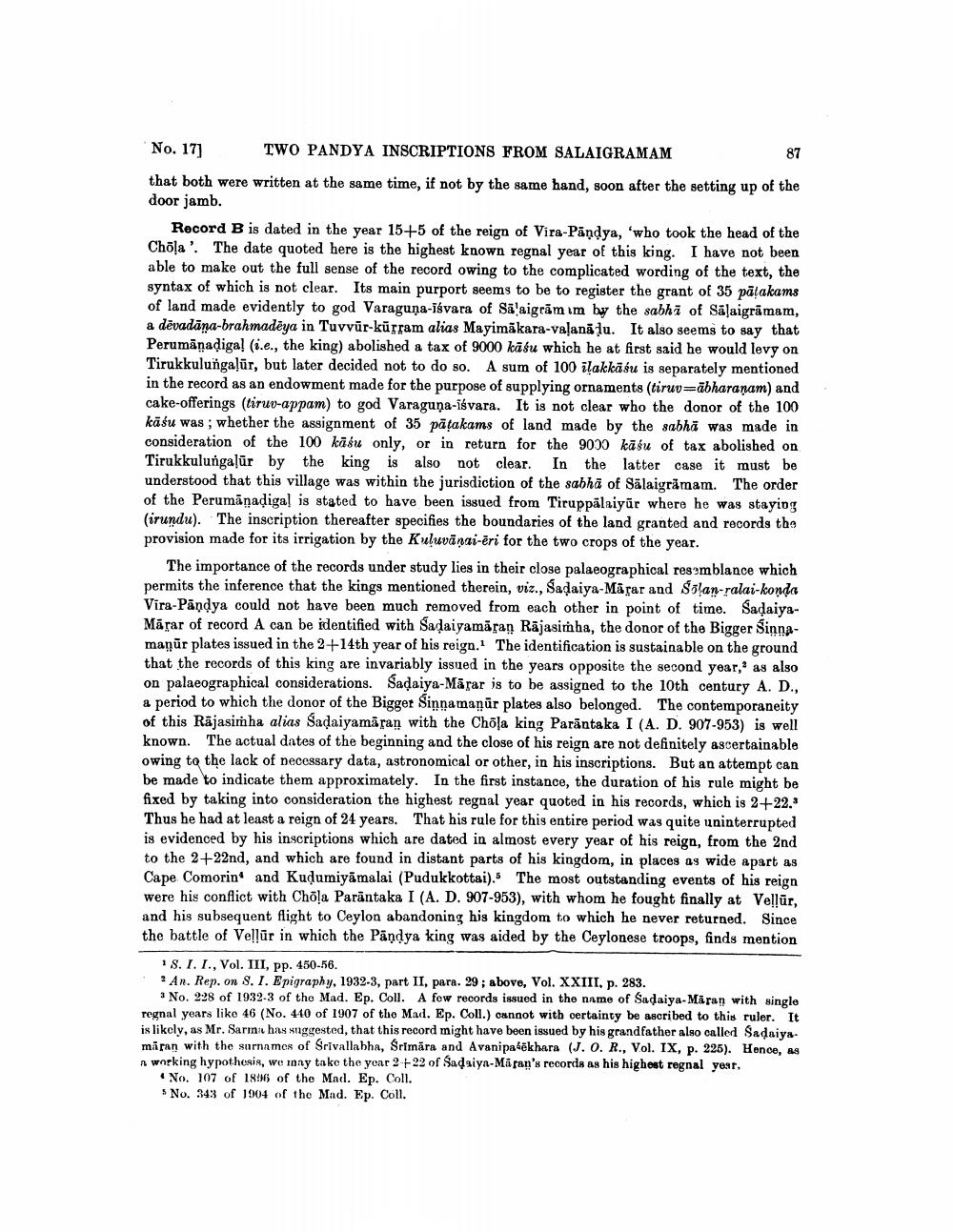________________
No. 17)
TWO PANDYA INSCRIPTIONS FROM SALAIGRAMAM
87
that both were written at the same time, if not by the same hand, soon after the setting up of the door jamb.
Record B is dated in the year 15+5 of the reign of Vira-Pāņdya, 'who took the head of the Chõļa'. The date quoted here is the highest known regnal year of this king. I have not been able to make out the full sense of the record owing to the complicated wording of the text, the syntax of which is not clear. Its main purport seems to be to register the grant of 35 pātakams of land made evidently to god Varaguna-īśvara of Sä'aigrāmim by the sabhi of Sāļaigrāmam, a dēvadāna-brahmadeya in Tuvvūr-kūrram alias Mayimăkara-vaļanāļu. It also seems to say that Perumāņadiga! (i.e., the king) abolished a tax of 9000 kāśu which he at first said he would levy on Tirukkulungaļür, but later decided not to do so. A sum of 100 ilakkäsu is separately mentioned in the record as an endowment made for the purpose of supplying ornaments (tiruv=ābharanam) and cake-offerings (tiruv-appam) to god Varaguņa-iśvara. It is not clear who the donor of the 100 kāśu was ; whether the assignment of 35 patakams of land made by the sabha was made in consideration of the 100 kāśu only, or in return for the 9000 kāśu of tax abolished on Tirukkulungaļūr by the king is also not clear. In the latter case it must be understood that this village was within the jurisdiction of the sabhā of Sälaigrămam. The order of the Perumāņadiga! is stated to have been issued from Tiruppalaiyur where he was staying (irundu). The inscription thereafter specifies the boundaries of the land granted and records tha provision made for its irrigation by the Kuluvanai-ēri for the two crops of the year.
The importance of the records under study lies in their close palaeographical resemblance which permits the inference that the kings mentioned therein, viz., Sadaiya-Māfar and Solan-ralai-konda Vira-Pandya could not have been much removed from each other in point of time. SadaiyaMārar of record A can be identified with Sadaiyamāran Rajasimha, the donor of the Bigger Sinnamaņūr plates issued in the 2+14th year of his reign. The identification is sustainable on the ground that the records of this king are invariably issued in the years opposite the second year, as also on palaeographical considerations. Sadaiya-Mārar is to be assigned to the 10th century A. D., a period to which the donor of the Bigger Sinnamanür plates also belonged. The contemporaneity of this Rājasimha alias Sadaiyamāran with the Chola king Parāntaka I (A. D. 907-953) is well known. The actual dates of the beginning and the close of his reign are not definitely ascertainable owing to the lack of necessary data, astronomical or other, in his inscriptions. But an attempt can be made to indicate them approximately. In the first instance, the duration of his rule might be fixed by taking into consideration the highest regnal year quoted in his records, which is 2+22.* Thus he had at least a reign of 24 years. That his rule for this entire period was quite uninterrupted is evidenced by his inscriptions which are dated in almost every year of his reign, from the 2nd to the 2+22nd, and which are found in distant parts of his kingdom, in places as wide apart as Cape Comorin and Kudumiyāmalai (Pudukkottai). The most outstanding events of his reign were his conflict with Chola Parantaka I (A. D. 907-953), with whom he fought finally at Vellür. and his subsequent flight to Ceylon abandoning his kingdom to which he never returned. Since the battle of Vellur in which the Pandya king was aided by the Ceylonese troops, finds mention
18. I.I., Vol. III, pp. 450-56. 'An. Rep. on 8. I. Epigraphy, 1932-3, part II, para. 29; above, Vol. XXIII. p. 283.
No. 228 of 1932-3 of the Mad. Ep. Coll. A few records issued in the name of Sadaiya Märan with single regnal years like 46 (No. 440 of 1907 of the Mad. Ep. Coll.) cannot with certainty be ascribed to this ruler. It is likely, as Mr. Sarnt has suggested that this record might have been issued by his grandfather also called Sadaiyamaran with the surnames of Srivallabha, Srimära and Avanipatēkhara (J. O. R., Vol. IX, p. 225). Hence, as a working hypothesis, we ony take the year 2 +22 of Sadaiya-Maran's records as his highest regnal year,
No. 107 of 1896 of the Mad. Ep. Coll. No. 343 of 1904 of the Mad. Ep. Coll.




